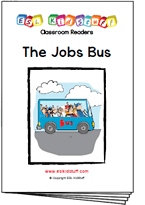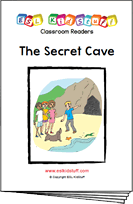Jobs lesson plan
Stand-alone lesson ESL kids lesson plan
Lesson plans for ESL kids teachers
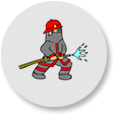
Jobs
In this lesson students learn 12 words for jobs and the structure “What do you do?”. Students do jobs-related activities, read a fun story about jobs and sing a jobs song.
Members get accompanying flashcards, worksheets, song and classroom reader.
Download materials:
Our lesson plans are FREE!
Sign up for accompanying:
✔ worksheets
✔ homework sheets
✔ craft sheets
✔ flashcards
✔ song downloads & videos
✔ classroom readers & videos
Click to see lesson details, materials and supplies
Time: 40 mins – 1 hour
Objectives: Asking about and saying 12 different jobs using the structure “What do you do?”.
Structures: “What do you do?”, “I’m a …”, “My dream job”, “I want to be a …”
Target vocabulary: farmer, bus driver, doctor, teacher, dentist, police officer, chef, hair dresser, nurse, soldier, fire fighter, student.
Lesson materials
Flashcards:
- farmer, bus driver, doctor, teacher, dentist, police officer, chef, hair dresser, nurse, soldier, fire fighter, student.
Printables:
- My dream job worksheet
- Jobs match 2 worksheet
- Reader worksheet
- What do you do? song poster
Songs:
- What do you do? (The jobs song)
Readers:
- The jobs bus
Additional materials:
- Jobs vocab crossword
- Jobs vocab word search
- Jobs spell & match worksheet
Supplies:
- [hide_on_uk]colored[/hide_on_uk][hide_on_us]coloured[/hide_on_us] pencils
- Blu-Tack or tape to stick flashcards to the board
- board with marker / chalk
- device to play the song on
The jobs in this lesson are familiar to kids of all ages, so this can be taught to even young kids.
Lesson procedure:
Warm up and maintenance:
The beginning of your lesson is extremely important: this is where you set the tone of your lesson and get everyone in the right frame of mind for learning English. It is also an opportunity to check homework and review previous lessons.
Click for warm up suggestions for the start of your lessons
These activities can be done in the following order at the start of your lesson:

1. Greetings and name tags
Greet the students by name as they enter the classroom and gesture for them to sit down. Before class prepare some blank name tags (stickers or pin-on tags). Give these out and have everyone write their names and put their tags on. If you use pin-on tags, you can keep and give out every class.

2. Homework check
Check each student’s homework set in the last lesson. Ask each student some questions about their homework worksheet (e.g. “what [hide_on_uk]color[/hide_on_uk][hide_on_us]colour[/hide_on_us] is it?”), give lots of praise, and then put some kind of mark on the homework sheet (e.g. a sticker, a stamp or draw a smiley face). Finally, tell your students to put their homework back into their bags.
3. Review past lessons
Reviewing past lessons is very important – students need constant practice of new vocab, structures, songs, games and so on. Always review parts of your last lesson as well as some parts from other previous lessons. You can spend 5-10 minutes reviewing – it’s fine to recycle games and activities from your past lessons to review as kids enjoy playing familiar games (although be careful not to play a game to death!). See the section “Other ideas to include in your warm” below for ideas.
You can also include review activities in the main body of your lesson. Kids can have short attention spans so it’s good to be able to pull out lots of activities during different stages of the lesson.
Other ideas to include in your warm up:
Ball pass questions
This is good to review questions from previous lessons. Get everybody standing in a circle.
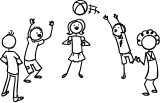
Round 1:
Take a ball and hold it and say, “My name is (you name)”. Then throw the ball to one student and say, “What’s your name?”. Students throw the ball around randomly, saying their names and asking for names.
Round 2:
This time ask a review question, e.g. “How many tables are there?”. Then throw the ball to a student who should answer, “There are (6) tables”. Help if necessary. Then that student throws the ball to another student and asks a “How many …?” question. Continue so everyone has a go. You can have multiple rounds with different topic questions.

Play “Spin the bottle”
Sit students in a circle with a bottle in the middle. Teacher spins the bottle. When it stops spinning the student it is pointing to has to answer a question. If the answer is correct then that student can spin the bottle. This is a good class warm up activity (e.g. How are you? What’s your [hide_on_uk]favorite[/hide_on_uk][hide_on_us]favourite[/hide_on_us] food? How’s the weather today?, etc.
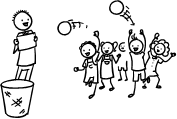
Play “Vocabulary basketball”
This is a fun game which reviews vocabulary from previous lessons. You will need a basket (a trash can) and 2 balls (or 2 pieces of A4 paper scrunched up into balls).
Form 2 teams and line them up so that two players from each team are facing the front with the basket in front of them. Let both players throw their ball – if they get their ball into the basket they can try and win a point by giving the correct answer to a question the teacher asks. This can be an actual question (e.g. What are you wearing?) or a flashcard (What’s this?). Then they go to the back of the line. At the end, the team with the most points is the winner!
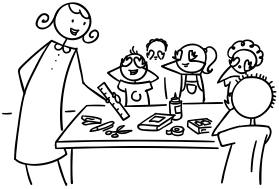
Play “What’s missing?”
This is a fun review memory game – students will have to try to remember review objects from previous lessons (e.g. classroom stationery). Lay the objects out on a table for all to see. Allow the students a minute to memorize the positions of the objects. Remove an object and hold it behind your back. Say, “Open your eyes!” – the first student who can shout out the missing object wins a point for his/her team. Play for all the objects.
Finally, calculate which team has won the most points and give them a round of applause.

Play “Quiz game show”
This is a fun quiz game, like a simple version of a TV game show. Draw some circles on the board and randomly write numbers 1, 2 or 3 in each circle. These will be points.
Put students into teams. Then ask the first team to choose a number – 1 is an easy question (e.g. “Do you like bananas?”) and 3 is a difficult question (e.g. point at a clock and ask, “What time is it?”). 2 will be in between in terms of difficulty. When the question has been answered correctly, erase that number circle. Play until all the number circles are gone – the team with the most points is the winner!
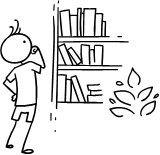
Read a classroom reader again
As you progress through the lessons you will start to build up a catalog of classroom readers (see our Readers download page at https://www.eslkidstuff.com). Kids love going back to old stories and reading through them again. Invite a student to pick a classroom reader and read through it as a class. Make the story as interactive as possible by asking questions (e.g. what [hide_on_uk]colors[/hide_on_uk][hide_on_us]colours[/hide_on_us] there are, the names of different objects, etc.) and getting students to speculate what is going to happen next in the story.

Talk about the weather (do after you have taught the weather lesson plan).
- Prepare a weather board. Before the first class prepare a piece of cardboard and cover it with felt – you are going to pin this to the wall. If you can, try and get blue felt (to represent the sky). Write at the top in large letters, “How’s the weather today?”. Below that write “Today it’s”. Cut out weather pictures (such as our weather flashcards) and stick some velcro on the back. Arrange the weather pictures around the edge of the board and then put the board on the wall of your classroom. You can now use this weather board at the beginning of every lesson.
- Ask about the weather. Ask, “How’s the weather today?” and have students put up their hands. Allow one weather condition per student (e.g. “It’s rainy”) and have each student come up and put a weather picture on the weather board.
- Introduce more weather vocabulary. Depending on weather conditions, you can introduce more weather words (with pictures … you can get students to draw them), such as:
- stormy
- misty
- showery
- freezing
- humid
- frosty
- icy
- drizzly
New learning and practice:
1. Teach jobs vocabulary
Before class, print off the jobs flashcards for the jobs in the song (farmer, bus driver, doctor, teacher, dentist, police officer, chef, hair dresser, nurse, soldier, fire fighter, student). If your students are older and can handle more vocabulary, feel free to add more jobs.
You’ll notice that one of the jobs is “student”. Although not technically a job, it is perfectly appropriate to answer the question “What do you do?” with “I’m a student”.
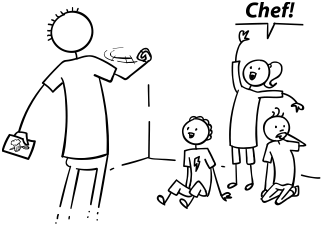
Now you are going to do actions for each job and your students will have to guess what jobs you are acting out.
Start by looking at the first flashcard (don’t show anyone) and do one of the below actions. Perhaps start with an easy one, like hairdresser, chef or bus driver. Encourage everyone to shout out their guesses – at this stage it is fine if students shout out the answers in their first language – you can correct and teach the new vocabulary as you go.
As each job is guessed, stick the flashcard onto the board and chorus the English word 3 times. Continue until all of the job flashcards are on the board.
- farmer: pretend to rake the soil, milk cows, pick vegetables from the ground and fruit from trees
- bus driver: pretend to drive a bus, beeping the horn, collecting money and giving out tickets
- doctor: pretend to give a student an injection in their arm, check their ears and inside mouth, and pretend to listen to their heart with a stethoscope
- teacher: point to yourself, pretend to write on an imaginary board
- dentist: demonstrate with a student: get him/her open their mouth whist you look inside and pretend to check, drill and even pull out teeth!
- police officer: hold out hand in the “Halt” position and blow a pretend whistle, shoot a gun and drive a police car with sirens blaring (say “nee-naa, nee -naa!”)
- chef: pretend to chop food and cook (stir a pot of food)
- hair dresser: pretend to cut hair and blow dry hair
- nurse: take a student’s pulse (two finders on inside of wrist) and check their temperature
- soldier: march around and pretend to shoot a rifle
- fire fighter: pretend to hold a hose and fire water at an imaginary fire
- student: point to everyone, pretend to write in an imaginary notebook
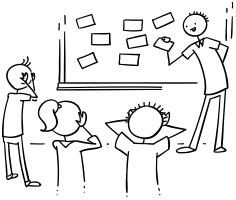
2. Play “Missing flashcards”
Now that you have all of the jobs flashcards on the board, tell everyone to close their eyes. Remove one of the flashcards. Then shout, “Open your eyes” and point to the space where the flashcard was. Encourage everyone to shout out what it is, then reveal the card.
The first person to shout out the correct answer can come to the board, say, “Close your eyes” and remove a flashcard. Keep playing until every card has been guessed.
3. Play “Paper, rock, scissors” flashcards
If your students don’t know how to play “Paper, rock, scissors” (known as jankan in Japan) start off by teaching and demonstrating the game.
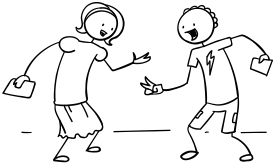
Next, give everyone a job flashcard – make sure you have enough flashcards to give one to each student. Say to one student, “What do you do?” and motion towards their card … elicit, “I’m a (soldier)” – whatever the flashcard is that s/he is holding. Write on the board:
“What do you do?”
“I’m a …”
Chorus each sentence three times. Then do a quick practice by asking some students, “What do you do?” and have them say the job of the flashcard they are holding. Also, have students ask you and other students, until everyone is comfortable with the structures.
Now for the game. Get 2 students to stand up to model the game. Start by playing “Rock, paper, scissors”. The winner gets to ask the loser “What do you do?” and the loser must reply “I’m a …” (saying the job on their card). Then the loser gives his/her card to the winner.
Ask another student to come and model with the winner: now one student has 2 cards and the other 1. They play “Rock, paper, scissors”, say the structure and the loser gives his/her card to the winner.
The aim of the game is to collect as many cards as possible. If a student has no cards left, that is fine – s/he can still play: if they win a game, they get a card, if they lose they remain with no cards (and do not say the structures).
Once everyone has got the idea, have all students to stand up and hold their flashcards. Get everyone to pair up and play. As soon as they have finished they must find another person to play with. Everyone mingles around the classroom playing “Rock, paper, scissors”, saying the structure and winning or losing cards.
After 5 minutes stop the game. The winner is the student with the most cards. This is a really popular game with my classes!
4. Read classroom reader “The jobs bus”
Now that the vocabulary and structures have been practiced we can move onto a fun, simple story which uses the target vocabulary. Before class, download and print off the reader “The jobs bus”. As you go through each page, point to the different characters and ask for the students to tell you what job they have, for example:
Teacher: (pointing on page 2) Look, what does he do?
Students: Farmer!
Teacher: Yes, that’s right! (reading) “I’m a farmer, Please take me to the farm”. etc.
Continue through the reader, eliciting the jobs and ask lots of other questions, such as asking the students where each person works, what they are wearing, etc.
After reading the story, give out a reader worksheet to each student and read through the story one more time (without stopping for questions, etc.) as students draw the route the bus takes in the story. Then check through as a class.
Alternatively, watch our video version of the reader (Internet connection required).
5. Sing the “What do you do?” song
The first time you play the song, put up the What do you do? song poster on the board. Quickly elicit the vocabulary. Play the song and sing along doing the gestures, as described below in Gestures. Play 2 or 3 times.
Lyrics for “What do you do?”
Do – do – do – do!
Do – do – do – do – do – do!
What do you do?
I am a farmer.
What do you do?
I’m a bus driver.
(What do you do?
I am a doctor.
What do you do?
I am a teacher.
Do – do – do – do!
What do you do?
I am a dentist.
What do you do?
I’m a police officer.
What do you do?
I am a chef.
What do you do?
I’m a hair dresser.
Do – do – do – do!
What do you do?
I am a nurse.
What do you do?
I’m a soldier.
What do you do?
I’m a fire fighter.
What do you do?
I’m a student.
Do – do – do – do – do – do – do!
Gestures for “What do you do?”
You can do either do gestures as you sing and dance along, or use flashcards for a listening activity.
- farmer: pretend to rake the soil
- bus driver: pretend to drive a bus
- doctor: pretend to give yourself an injection in your arm
- teacher: pretend to write on an imaginary board
- dentist: open mouth and touch teeth
- police officer: hold out hand in the “Halt” position and blow a pretend whistle
- chef: pretend to cook (stir a pot of food)
- hair dresser: pretend to cut hair
- nurse: take your pulse (two finders on inside of wrist)
- soldier: march on the spot
- fire fighter: pretend to hold a hose
- student: pretend to write in an imaginary notebook
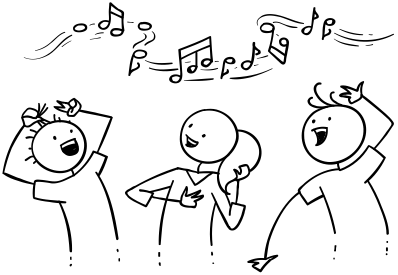
[hide_on_uk]Short sample (members get full-length song):
[/hide_on_uk]
[hide_on_us]Short sample (members get full-length song):
[/hide_on_us]
6. Do the “My dream job” worksheet
On the board, at the top, write “My dream job”. Chorus 3 times. Say, “I am a teacher” and point to yourself. Then say “But … I want to be a … “. Don’t say anything yet. Under the “My Dream Job” title draw a picture of a job (e.g. a police officer) and have everyone try and guess what your dream job is. It doesn’t have to be one of the jobs from the song – I always use “astronaut”.
Then give out the worksheets and have everyone draw their dream job and write the word. As they are drawing, go around the room asking questions and giving lots of praise and encouragement. When everyone has finished, get each student in turn to hold up their picture and say, “I want to be a/an …”. For higher level students you can ask them some questions, such as, “Why do you want to be (a doctor)?”.
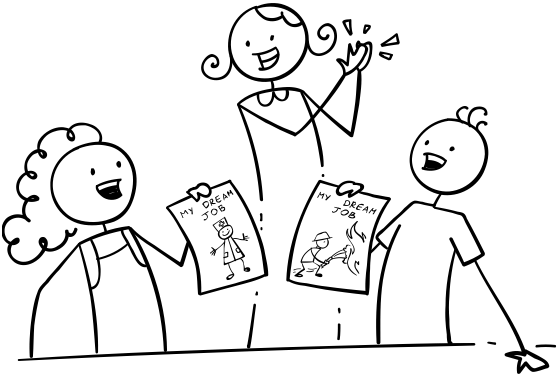
You can have everyone stick their worksheets to the wall or notice board under the title “Our dream jobs”. You can then use the pictures in future classes to review the vocabulary.
Wrap up:
Assign homework: “Jobs match 2” worksheet
Click for wrap up suggestions for the end of your lessons

1. Assign homework
Each week give out a homework worksheet for your students to take home. Hold up the homework worksheet and model how to do it. Give out the worksheets and say, “Put your homework in your bags”.

2. Do “Quick check”
Time to leave the class. Make sure everything is put away and the students have gathered their belongings. Have them line up at the door and place yourself between the door and the students. For each student check one new word or phrase, for example:
- hold up an object or flashcard (such as an item of clothing) and ask, “What’s this?”
- ask a question from the lesson (e.g. “Where do you live?”, “Do you like bananas?”, “Can you play chess?”, etc.)
When they give you the correct answer say goodbye and let them leave. If their answer is wrong, have them go back to the end of the line – they will have to try again once they reach the front!
Other lesson plans
Actions, verbs & tenses:
- Can – for ability
- Morning routines
- Daily routines & times of the day
- Actions – Present continuous
- Future plans using “going to”
- Past tense activities – Regular verbs
- Past tense activities – Irregular verbs: Part 1
- Past tense activities – Irregular verbs: Part 2
Adjectives:
- Describing people
- Describing things
- Comparing things (Comparative adjectives)
- Comparing things (Superlative adjectives)
Adverbs:
Alphabet:
Animals:
Body:
Classroom:
Clothes:
Colors:
Colours:
Directions:
Family:
Feelings & emotions:
Food:
Health & sickness:
Holidays & festivals:
Jobs:
Likes, dislikes & favorites:
Likes, dislikes & favourites:
- Likes & dislikes
- [hide_on_uk]Favorites[/hide_on_uk][hide_on_us]Favourites[/hide_on_us] and asking why
Nature & Our world:
Numbers:
Places & where we live:
Prepositions of location:
Pronouns:
Shapes:
Shopping:
Sports:
Time, days, months, seasons:
Toys:
Transport & travel:
Weather:


